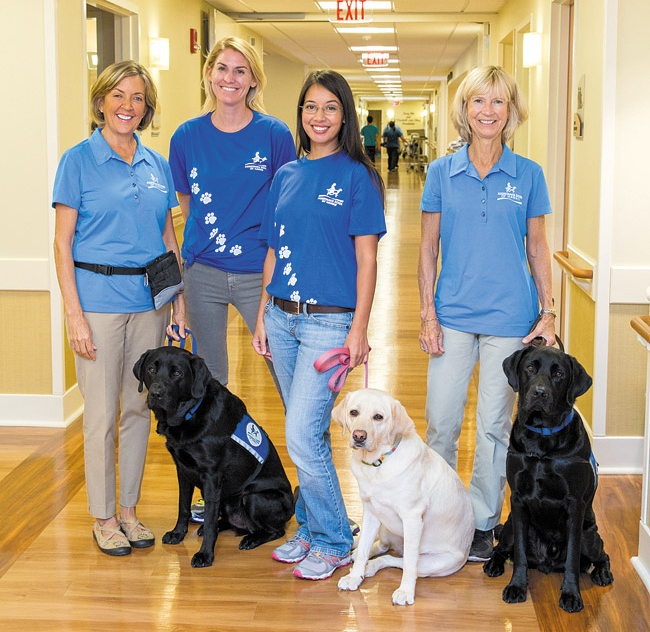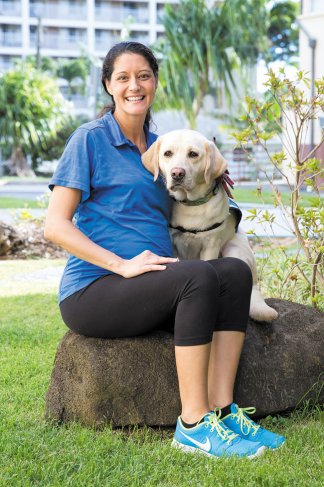Canine Caregivers
Since it first began in 2000, Assistance Dogs of Hawaii has trained more than 200 dogs that go on to support people with physical disabilities, work with children in hospitals and courtrooms, and even read sign language
Maureen “Mo” Maurer first knew she wanted to work with service dogs when she was just 10 years old.
mw-nm-010715-assistance-dogs-of-hawaii-ac-02
The idea came after reading Follow My Leader. In the book, author James B. Garfield tells the story of 11-year-old Jimmy, who becomes blind after an accident with firecrackers, and is feeling discouraged and depressed — until a therapist introduces him to the possibility of a guide dog. Eventually, Jimmy goes to the School for Blind, where he and his dog Leader learn to trust and work with one another.
“I was so intrigued by the idea of dogs being able to help people that it just really captivated me,” says Maurer.
Years later, recognizing a need in the community for a program like that, she quit her career as a CPA and in 2000 sold her practice. That same year, Maurer founded Assistance Dogs of Hawaii with husband Will. On 3 acres of land at the organization’s main campus on Maui, Maurer and her team have worked with more than 200 dogs since its inception. Assistance dogs are provided free of charge and include a lifetime of follow up.
It’s a selective process that really begins before a puppy is born.
Dogs are bred and raised at a guide dog school in Australia. From birth, they are handled, socialized and exposed to different environments. Then, at about 7 weeks old, a temperament evaluation determines whether each puppy is calm and confident, and if they are people-oriented and possess a strong work ethic.
Labradors and golden retrievers commonly are used because of these attributes. Their retrieve instinct also makes these breeds appropriate for tasks like picking up dropped objects for those with limited mobility.
Once Assistance Dogs of Hawaii selects its puppies, dogs undergo four stages of training that take up to two years to complete. They begin training together, all learning from the same curriculum. Then, much like college and graduate school, they are chosen for specific tracks. Some go on to be service dogs, working with one person. Others become facility dogs and eventually work in places like hospitals and courthouses. The industry average of dogs succeeding, says Maurer, is about 30 percent. For Assistance Dogs of Hawaii, however, it is 70.
The final stage, pairing dogs with owners, is just as closely scrutinized.
“We’re really careful about them matching, and that’s why I think we have never had a team that didn’t work out,” Maurer notes.
Ultimately, working with those who have overcome life’s adversities inspires her.
“I feel like all the people who get the dogs are heroes. It sounds kind of corny, but they really are,” says Maurer. “This program is a ministry for us, and it’s just a way to be a blessing, like the dogs.”
There are a number of dogs that have graduated from the accredited organization and are now working throughout Hawaii and even in Japan. They can be seen walking the halls of hospitals, in courthouses or by an owner’s side. A few currently are participating in a research project focused on a dog’s ability to detect infections in hospitalized patients.
Here is a look at just a few of these four-legged workers.
Angel
It’s impossible to get very far if you’re walking the halls of Rehabilitation Hospital of the Pacific with Angel. Everywhere she goes, there’s a patient who wants just a moment with her.
“Thank you, Angel, I know you’re looking over me,” croons one patient, who stopped to stroke her face, occasionally planting a kiss on the obedient Labrador’s nose.
It’s beautiful to watch. Scenes like this are a common occurrence at the hospital, where 2-year-old Angel works from 8:30 a.m. to 5 p.m. five days a week. Aside from the emotional support she provides to patients, she keeps busy working with the hospital’s animal assisted therapy program.
As part of their therapy, patients may choose to take three classes that allow them to interact and work with Angel. Stroke survivors working to improve their dexterity, for example, may take a grooming class. Completing tasks like taking off Angel’s jacket and leash, and brushing her coat, ultimately enhance a patient’s fine motor skills.
Other times, Angel may be called upon to work with patients who are only able to turn their head in one direction. To assist, she sits on the affected side as motivation for patients to turn and pet her. She even simply will take a walk with those who need to improve their mobility and ambulation skills.
“The smiles on everybody’s faces and the unconditional love that the animals bring to our patients, it’s just phenomenal,” says Kate Julian, recreational therapist and Angel’s handler.
Pono
Pono’s greetings are warm and playful. But at work at the City and County of Honolulu Department of the Prosecuting Attorney’s Office, she is a source of stoic calm, much needed for the people she interacts with on a daily basis.
As a courthouse dog, 7-year-old Pono works primarily with children who have witnessed a crime, or have been involved with physical or sexual abuse. In interviews about these experiences with prosecutors, children are able to sit with Pono’s head in their lap, putting them at ease and making the entire process less intimidating. Sometimes, she even helps to calm the parents and other adults with whom the office may be working.
Handler Dennis Dunn initially was skeptical about the program, and the last time he owned a dog was at least three years ago. But after learning more about it, Dunn saw the potential value and volunteered to be Pono’s caretaker. Whatever initial doubt he had and however long it had been since his last dog, you’d never be able to guess. As he speaks, he sometimes turns to address Pono instead, rubbing her ears and occasionally passing her a treat. It’s a bit heartwarmingly silly, yes, but it also is exactly the type of effect Pono is meant to draw out of those she works with.
Her presence in an office of employees who work long hours on difficult cases also provides a morale boost. Those lucky enough to be in the office at the right time sometimes get to spend a moment with her during “Pono playtime.” If Dunn isn’t able to schedule these sessions, he makes it a point to take Pono around the office.
“I just walk from door to door and just say hi to everybody and just give them the chance to interact with her, and it really seems to make a difference,” he says.
Tucker
Tucker has become somewhat of a facility dog celebrity. At Kapiolani Medical Center for Women and Children, where he works Monday to Friday under the title of chief canine officer, a stuffed animal “Tucker” even is available in the gift store.
Still, 9-year-old Tucker handles the fame with a temperament that has made him popular with patients, hospital staff and thousands of Facebook and Instagram followers who keep up with him.
He works with handler and child psychologist Wendi Hirsch, typically with children and families in the pediatric oncology unit. Sometimes, he lies with patients (“snuggle” is the most popular command he knows) and other times, he leads by example.
“Tucker can get kids to do things here at the hospital like nobody else can,” says Hirsch.
Children who have been in the hospital for extended periods and are afraid to start walking again, for instance, will get out of bed to follow Tucker. In other scenarios, children will watch Tucker calmly take his fish oil pill and feel less afraid of taking their own medication.
With staff, he is just as supportive. Sometimes, with oncology cases, desired outcomes are not always achieved. In meetings when these cases are being discussed, Hirsch says Tucker will go around to each staff member and lay at their feet or sit next to them as they talk.
But with all that work, Tucker does manage to schedule in some down time.
“He is the only staff member who is allowed to sleep on the job. It’s in his contract,” says Hirsch with a laugh.
Zeus
An instructor in the special education department at University of Hawaii at Manoa, Brian Kajiyama sat in his wheelchair in front of his office, looking at the keys he had just dropped on the ground. Suddenly, he felt his confidence drop.
“Then I saw big brown eyes staring at me,” he recalls. “It was Zeus with his tail wagging. It was as if he was saying, ‘Don’t worry, I’m here to help!'”
Feeling reassured, Kajiyama signaled to Zeus for his keys and was able to enter the office within seconds.
That happened when Kajiyama first got Zeus. Now 7 years old, he is Kajiyama’s first service dog. He really wasn’t looking for one at the time, he says, but a friend connected him with Assistance Dogs of Hawaii.
“Once I saw Zeus, I was sold,” he says.
Afflicted with cerebral palsy, Kajiyama communicates with the aid of a speaking device. To accommodate his needs, Assistance Dogs of Hawaii trained Zeus using modified American Sign Language that allows Kajiyama to give commands using his right hand. The first dog to be trained using this method, Zeus now knows more than 90 verbal and sign language cues.
His experience with Zeus, Kajiyama says, has been empowering and enlightening.
“I’ve seen the notion of ‘disability’ disappear,” he says. “By this, I mean people who probably wouldn’t have approached me now do so and engage me in conversation about my dog.”
For more information on Assistance Dogs of Hawaii and to make a donation or volunteer, visit assistancedogshawaii.org or find it on Facebook.







